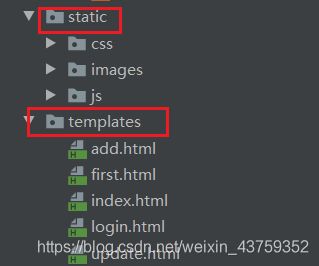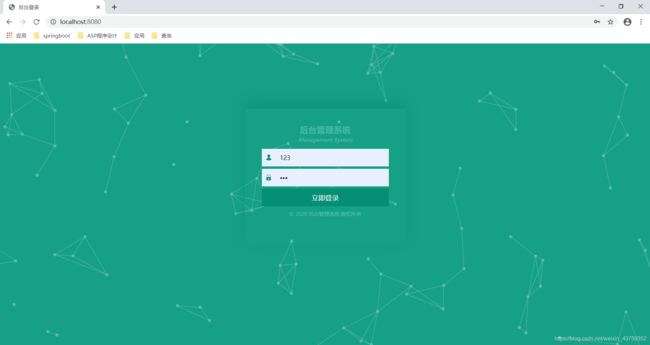SpringBoot总结(十)——SpringBoot+Mybatis实现数据库的CRUD(从创建到实现【超详细附代码】)
一、创建项目。
这里创建的项目名是springboot-web3-mybatis。
1、点击左上角的File——>Project

2、选择Spring Initializr 点击Next。

3、填写相应的项目名、工程名等,点击Next。

4、选择Web 勾选Spring Web 点击Next。

5、项目创建成功。
二、导入依赖。
<!-- mybatis-spring-boot-starter 整合 -->
<dependency>
<groupId>org.mybatis.spring.boot</groupId>
<artifactId>mybatis-spring-boot-starter</artifactId>
<version>2.1.1</version>
</dependency>
<!--Springboot官方的-->
<dependency>
<groupId>org.springframework.boot</groupId>
<artifactId>spring-boot-starter-jdbc</artifactId>
</dependency>
<!--lombok-->
<dependency>
<groupId>org.projectlombok</groupId>
<artifactId>lombok</artifactId>
</dependency>
<!--thymeleaf模板-->
<dependency>
<groupId>org.thymeleaf</groupId>
<artifactId>thymeleaf-spring5</artifactId>
</dependency>
<dependency>
<groupId>org.thymeleaf.extras</groupId>
<artifactId>thymeleaf-extras-java8time</artifactId>
</dependency>
<dependency>
<groupId>mysql</groupId>
<artifactId>mysql-connector-java</artifactId>
<version>5.1.37</version>
<scope>runtime</scope>
</dependency>
三、创建页面、导入静态资源。
- 静态资源css、js、image等放在static文件夹下。
- html文件放在templates文件下。

具体页面:
add.html ——增加学生信息的页面
first.html —— 首页
index.html ——页面展示页
login.html ——登录页面
update.html——更改信息页面
四、更改引用资源文件,让项目能够运行。
这里使用的是thymeleaf模板,具体详解可以参考以下文章thymeleaf使用
五、编写controller。
UserController.java
package com.example.Controller;
import com.example.mapper.UserMapper;
import com.example.pojo.User;
import org.springframework.beans.factory.annotation.Autowired;
import org.springframework.stereotype.Controller;
import org.springframework.ui.Model;
import org.springframework.util.StringUtils;
import org.springframework.web.bind.annotation.RequestMapping;
import org.springframework.web.bind.annotation.RequestParam;
import javax.servlet.http.HttpSession;
@Controller
public class UserController {
@Autowired
private UserMapper userMapper;
@RequestMapping("/login")
public String login(@RequestParam("username") String username, @RequestParam("password") String password, Model
model, HttpSession session){
User user=userMapper.selectUser(username, password);
if(!StringUtils.isEmpty(user)){
session.setAttribute("loginUser", username);
return "/first"; //登录成功!
}else{
model.addAttribute("msg","用户名或密码错误");
return "login";
}
}
}
StudentController.java
package com.example.Controller;
import com.example.mapper.StudentMapper;
import com.example.pojo.Student;
import org.springframework.beans.factory.annotation.Autowired;
import org.springframework.stereotype.Controller;
import org.springframework.ui.Model;
import org.springframework.web.bind.annotation.GetMapping;
import org.springframework.web.bind.annotation.PathVariable;
import org.springframework.web.bind.annotation.PostMapping;
import java.util.Collection;
@Controller
public class StudentController {
@Autowired
private StudentMapper studentMapper;
//查找学生的所有信息
@GetMapping("/queryStudentList")
public String queryStudentList(Model model) {
Collection<Student> studentList = studentMapper.queryStudentList();
model.addAttribute("queryStudentList",studentList);
return "index";
}
//增加学生信息
@GetMapping("/add")
public String toAddpage(){
return "add";
}
@PostMapping("/addStudent")
public String addStudent(Student student) {
studentMapper.addStudent(student);
return "redirect:/queryStudentList";
}
//更改学生信息
@GetMapping("/update/{id}")
public String toUpdatepage(@PathVariable("id")Integer id, Model model){
//查出所有的数据
Student stu=studentMapper.queryStudentById(id);
model.addAttribute("stud",stu);
return "update";
}
@PostMapping("/updateStudent")
public String updateUser(Student student) {
studentMapper.updateStudent(student);
return "redirect:/queryStudentList";
}
//根据学号id删除学生信息
@GetMapping("/deleteStudent/{id}")
public String deleteUser(@PathVariable("id")int id) {
studentMapper.deleteStudent(id);
return "redirect:/queryStudentList";
}
}
六、编写mapper。
UserMapper.java
package com.example.mapper;
import com.example.pojo.User;
import org.apache.ibatis.annotations.Mapper;
import org.springframework.stereotype.Repository;
//这个注解表示了这是一个mybatis的mapper
@Mapper
@Repository
public interface UserMapper {
User selectUser(String username, String password);
}
StudentMapper.java
package com.example.mapper;
import com.example.pojo.Student;
import org.apache.ibatis.annotations.Mapper;
import org.springframework.stereotype.Repository;
import java.util.List;
//这个注解表示了这是一个mybatis的mapper
@Mapper
@Repository
public interface StudentMapper {
List<Student> queryStudentList(); //查找学生的所有信息
Student queryStudentById(int id); //根据学号id查找信息
int addStudent(Student student); //增加学生信息
int updateStudent(Student student); //更改学生信息
int deleteStudent(int id); //根据学号id删除学生信息
}
七、编写pojo类。
User.java
package com.example.pojo;
public class User {
private int id;
private String username;
private String password;
public User() {
}
public User(int id, String username, String password) {
this.id = id;
this.username = username;
this.password = password;
}
public int getId() {
return id;
}
public void setId(int id) {
this.id = id;
}
public String getUsername() {
return username;
}
public void setUsername(String username) {
this.username = username;
}
public String getPassword() {
return password;
}
public void setPassword(String password) {
this.password = password;
}
@Override
public String toString() {
return "User{" +
"id=" + id +
", username='" + username + '\'' +
", password='" + password + '\'' +
'}';
}
}
Student.java
package com.example.pojo;
import java.util.Date;
public class Student {
private int id;
private String name;
private Integer sex;
private int age;
private String score;
private String address;
private Date date;
public Student() {
}
public Student(int id, String name, Integer sex, int age, String score, String address, Date date) {
this.id = id;
this.name = name;
this.sex = sex;
this.age = age;
this.score = score;
this.address = address;
this.date = date;
}
public int getId() {
return id;
}
public void setId(int id) {
this.id = id;
}
public String getName() {
return name;
}
public void setName(String name) {
this.name = name;
}
public Integer getSex() {
return sex;
}
public void setSex(Integer sex) {
this.sex = sex;
}
public int getAge() {
return age;
}
public void setAge(int age) {
this.age = age;
}
public String getScore() {
return score;
}
public void setScore(String score) {
this.score = score;
}
public String getAddress() {
return address;
}
public void setAddress(String address) {
this.address = address;
}
public Date getDate() {
return date;
}
public void setDate(Date date) {
this.date = date;
}
@Override
public String toString() {
return "Student{" +
"id=" + id +
", name='" + name + '\'' +
", sex=" + sex +
", age=" + age +
", score='" + score + '\'' +
", address='" + address + '\'' +
", date=" + date +
'}';
}
}
八、编写具体Mybatis的配置文件。
UserMapper.xml
<?xml version="1.0" encoding="UTF-8" ?>
<!DOCTYPE mapper
PUBLIC "-//mybatis.org//DTD Mapper 3.0//EN"
"http://mybatis.org/dtd/mybatis-3-mapper.dtd">
<mapper namespace="com.example.mapper.UserMapper">
<select id="selectUser" resultType="User">
select * from user where username = #{
username} and password=#{
password}
</select>
</mapper>
StudentMapper.xml
<?xml version="1.0" encoding="UTF-8" ?>
<!DOCTYPE mapper
PUBLIC "-//mybatis.org//DTD Mapper 3.0//EN"
"http://mybatis.org/dtd/mybatis-3-mapper.dtd">
<mapper namespace="com.example.mapper.StudentMapper">
<select id="queryStudentList" resultType="Student">
select * from student
</select>
<select id="queryStudentById" resultType="Student">
select * from student where id = #{
id}
</select>
<insert id="addStudent" parameterType="Student">
insert into student (id,name,sex,age,score,address,date) values (#{
id},#{
name},#{
sex},#{
age},#{
score},#{
address},#{
date})
</insert>
<update id="updateStudent" parameterType="Student">
update student set name=#{
name},sex=#{
sex},age=#{
age},score=#{
score},address=#{
address},date=#{
date} where id = #{
id}
</update>
<delete id="deleteStudent" parameterType="int">
delete from student where id = #{
id}
</delete>
</mapper>
九、配置文件,applicatiuon.yml。
spring:
datasource:
driver-class-name: com.mysql.jdbc.Driver
url: jdbc:mysql://localhost:3306/springboot_data?serverTimezone=UTC&useUnicode=true&characterEncoding=utf-8
username: root
password: 123
thymeleaf:
cache: false
# 整合mybatis
mybatis:
type-aliases-package: com.example.pojo
mapper-locations: classpath:mybatis/mapper/*.xml
十、数据库,数据库springboot_data 表:user、student表。
十一、启动项目。
1、项目启动成功后、访问http://localhost:8080/默认的端口号。

2、用户名123 密码123登录成功。进入首页。

3、点击学生信息。

4、增加学生。

5、修改学生信息。

本篇是简单的实现数据库的操作,希望给大家一些帮助。
项目完整源码私信可以获取哦

